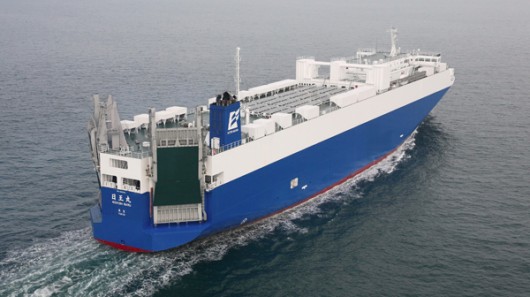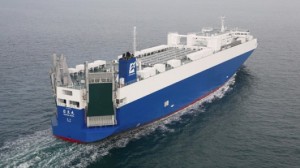With large cargo freighters being a major source of CO2 emissions worldwide it’s been encouraging to see various efforts to make such vessels more efficient. In recent years we’ve seen the development of the world’s biggest container ship to cut CO2 emissions per container moved, air bubbles used to cut the friction between a ship’s hull and the ocean, and even plans to return to the use of sails to cut fuel use. Now Nissan has launched an energy efficient coastal car carrier called the Nichio Maru that employs solar panels, LED lighting, a low friction hull coating hull and an electronically controlled diesel engine to cut fuel consumption.

The newly built Nichio Maru began its maiden voyage on January 7, 2012, and is the first coastal cargo ship in Japan to have photovoltaic solar panels installed. There are 281 solar panels in all, fitted to the ship’s deck and used to power the LED lighting installed in the ship’s hold and crew quarters.
Other energy efficiency features include the electronically controlled diesel engine that gives the 169.95 m (557 ft) long, 26 m (85 ft) wide vessel an operating speed of 21.2 knots (24.5 mph/39 km/h), and the use of a low friction hull coating that provides better sea mileage.
Nissan says, when compared to an existing car carrier of the same type, these features allow the Nichio Maru to achieve a fuel reduction of up to nearly 1,400 tons annually, which translates to an annual reduction in CO2 emissions of 4,200 tons.
The Nichio Maru can carry up to 1,380 cars and will operate on the main maritime route among the Kanto (Oppama), Kinki (Kobe) and Kyushu (Kanda) regions, making two round trips each week.
Part of Nissan‘s mid-term environmental action plan, Nissan Green Program 2016, the Nichio Maru joins “The City of St. Petersburg” energy efficient car carrier that the company began using in 2010 to transport its LEAF electric vehicles across Europe. That vessel boasts a sleek and semi-spherical bow to cut wind resistance by up to 50 percent, resulting in an estimated fuel reduction of 800 tons and 2,500 ton reduction in CO2 emissions annually.
Here’s a video from Nissan profiling the Nichio Maru.

 Follow
Follow
